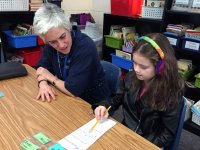6 Strategies for Differentiated Instruction in Project-Based Learning
Reflecting on learning and student voice and choice are core elements of project-based learning, and they’re also key to differentiation.
Project-based learning (PBL) naturally lends itself to differentiated instruction. By design, it is student-centered and student-driven, and it gives space for teachers to meet the needs of students in a variety of ways. PBL can allow for effective differentiation in assessment as well as daily management and instruction.
PBL experts will tell you this, but I often hear teachers ask for real examples, specifics to help them contextualize what it looks like in the classroom. We all need to try out specific ideas and strategies to get our brains working in a different context. Here are some specific differentiation strategies to use during a PBL project.
1. Differentiate Through Teams
We all know that heterogeneous grouping works, but sometimes homogenous grouping can be an effective way to differentiate in a project. Sometimes in a novel- or literature-based PBL project, for example, it might be appropriate to differentiate by grouping students by reading level. That way, I can take groups that need intensive work and ensure they are getting the instruction they need.
Teaming should be intentional, and we need to know the why of how we structure teams. Are you differentiating for academic ability? Are you differentiating for collaboration skills? Are you differentiating for social-emotional purposes? Are you differentiating for passions? If you’re a designer or co-designer of a PBL project, teams can be an effective way to differentiate instruction.
2. Reflection and Goal Setting
Reflection is an essential component of PBL. Throughout the project, students should be reflecting on their work and setting goals for further learning. This is a great opportunity for them to set personalized learning goals and for you to target instruction specific to the goals they set.
At specific milestones in a project, one teacher that I observed had students reflect on what they’d learned so far in math and science, and then create goal statements for what they still wanted to learn. The teacher then designed activities to support students in learning not only what they wanted, but also what they needed to know.
3. Mini-Lessons, Centers, and Resources
This is probably one of my favorites. In addition to being a great management strategy to prevent time sucks in class, mini-lessons and centers are a great way to differentiate instruction. Perhaps you offer mini-lessons or center work to support your students’ learning, or maybe you show students a variety of resources from which to learn, including videos, games, and readings.
I know a teacher who has a well-oiled PBL machine of a classroom. Students move seamlessly from product work to learning stations, resources, and mini-lessons based on what they know. Students are so in tune with their learning that they are able to truly take ownership of it, and the teacher provides instruction without assumption. Not all students may need the mini-lesson, so you can offer or demand it for the students who will really benefit.
4. Voice and Choice in Products
Another essential component of PBL is student voice and choice, both in terms of what students produce and how they use their time. With the products, you can allow students to show what they know in a variety of ways. From written components to artistic or theatrical, you can differentiate the ways that students are summatively assessed. Their passions actively come into play here.
Again, it all depends on the standards that you’re assessing, but don’t let standards confine your thinking. Yes, you may have a written component if you’re assessing writing, but ask yourself, “How can I allow for voice and choice here?” Embrace possibilities for differentiated student summative products.
5. Differentiate Through Formative Assessments
Formative assessments can look the same for all students. They can also look different. We know that students can show what they’ve learned in different ways, as mentioned above in terms of products produced as summative assessment. In addition, as you check for understanding along the way, you can formatively assess in different ways when appropriate.
Perhaps you are targeting collaboration in the project. You can differentiate a formative assessment of this in a variety of ways. Perhaps it’s an oral conference. Perhaps it’s a series of written responses. Perhaps it’s a graphic organizer or collage. More importantly, these formative assessments allow you to differentiate the type of instruction needed as you feed forward in the project.
6. Balance Teamwork and Individual Work
Teamwork and collaboration occur regularly in a PBL project. We want to leverage collaboration as much as content. However, there are times when individual instruction and practice may be needed. You need to differentiate the learning environment because some students learn better on their own, and others learn better in a team. In fact, we all need time to process and think alone just as much as we need time to learn from our peers. Make sure to balance both so that you are supporting a collaborative environment while allowing time to meet students on an individual basis.
As you master the PBL process in your classroom, you will intuitively find ways to differentiate instruction for your students. You will design the project to scaffold content and skills in a variety of ways. You will create formative and summative assessments to allow for student passions and goals, and you will manage the process so that it allows you to meet students where they are and move them forward.
